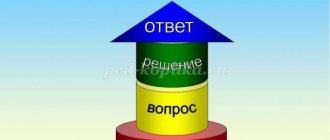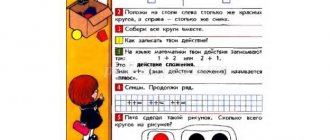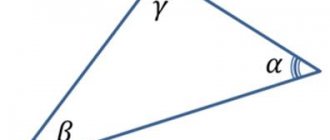Summary of a lesson in mathematics on the topic "Compound problem" 2nd grade
Subject:
Composite problem (problems to find the sum and remainder)
Goals:
1) developing students’ knowledge about component tasks and methods for solving them; formation of skills to independently construct and apply new knowledge;
2) develop logical thinking and memory;
3) develop mutual respect and accuracy;
Equipment:
textbook, didactic material, material for mental calculation
During the classes:
- Organizing time
We begin again Solving, guessing, counting Put your mind and heart into your work, Treasure every second of your work!
Get to work, guys, quickly, learn to count so as not to lose count!
2. Oral counting. Repetition of covered material
1. Game "Skydivers"
There are no clouds on the horizon, But an umbrella has opened in the sky. A few minutes later He went down...
(Parachute)
- Guys, we need to help the paratroopers land. To do this you need to solve examples.
12-10 7+6 13-10
30+5 7+10 80-30
30+70 60+20 55-5
18-10 90-80 60-20
- Working with cards
— In the last lesson we worked on the topic “Perimeter”
— What is the perimeter?
— There are cards on your desks. To complete the task you will need a ruler. Measure the sides of the rectangle and find the perimeter
- Communicating the purpose and topic of the lesson
- Well done boys. We counted orally and repeated the previous topic. And today in class we will solve compound problems. These are problems that can be solved in 2 steps.
- Learning new material
-Listen carefully to the task:
“The seamstress sewed 3 potholders, and then 8 more. How many potholders did she sew in total?”
-Please repeat the task
Brief note on the board:
I sewed 3 rows and 8 rows.
How many total...?
- What action should be taken to solve the problem?
- Let's continue this task. The seamstress had only... We just found out how many pot holders she had (11). So, the seamstress had 11 potholders, and she gave 4 as a gift. How many potholders does she have left?
Short note on the board (write under the first short note):
Was…
Gave - 4 ave.
Left - ?
How to solve this problem?
—
Let's see how we can make one out of these two problems, the teacher circles two lines on the board (How many in total? And it was...)
I sewed - 3 ave. and 8 ave.
Gave - 4 ave.
Left - ?
- Read the new problem.
— The new problem that you have compiled differs from the problems that we solved before in that it is solved in two actions.
-What do we learn as the first action?
-What did we learn in the second action?
— Is it possible to write the solution to this problem as an expression?
— such tasks are called compound because they were made up of several tasks.
- Fizminutka
One - rise, stretch, Two - bend down, straighten up, Three - clap your hands, three claps, Three nods with your head. At four - arms wider, at five - to wave your arms, at six - to sit quietly in your place.
- Reinforcing the material learned
— Page 75 No. 2
- Solve the problem.
There are 7 blue and 4 green parrots in the pet store. How many parrots were there in the store?
— let’s come up with a continuation of the problem statement.
There are 7 blue and 4 green parrots in the pet store. We sold 5 birds in one day. How many parrots are left in the pet store?
— Is it possible to immediately answer the question of the task? What you need to know first7 What then?
1) 7+4=11
2) 11-5=6
Expression: (7+4)-5=6
- Well done!
7. Working with didactic material
- Name the geometric shapes. How are squares and rectangles different, what are they similar, and how are they different?
— There are tokens with numbers on each table. I will point to the picture. You must count the squares and show the corresponding number.
And now to find out what is shown on the card, you need to connect the numbers in order.
- What did you do? (Grasshopper)And now you need to color it. What color should we paint it? (Green)
8. Lesson summary. Reflection.
- What new did you learn?
— What was interesting for you?
-Which tasks were difficult for you?
- Everyone did well today. Now show your mood. Draw a smile on the smiley face. And give it to your desk neighbor.
This concludes our lesson!
so UNT / Lesson developments / Lessons in Mathematics
Mathematics 2nd grade. Topic: Composite problem
01/05/2015 4895 0 Khvalova Lyubov Nikolaevna Purpose of the lesson: To form the concept of a compound problem, to develop the skills of composing and solving a problem according to a short condition; develop self-educational skills; to develop students’ skills of adequate self-esteem; - develop logical and critical thinking, attention, memory, ability to analyze and draw conclusions; develop students' cognitive activity; expand your reading horizons; - to cultivate neatness, love of nature, and a friendly attitude towards others. Lesson type: learning a new topic. Lesson type: verbal, visual, partially search. Expected result: children will be able to solve compound problems. Will be able to solve expressions for addition and subtraction of two-digit numbers
Design: cards for mental counting; green cards with multi-level tasks, yellow cards for individual counting, cards with letters and answers for written examples; table “Evaluate yourself”, Lesson progress: I. Psychological attitude.
- I will smile at you, you will smile at each other and think how good it is that we are together today. We are calm, kind and healthy. I hope that you and I will make this lesson useful for all of us.
Reading a poem by the teacher. Tree, flower, grass and birds do not always know how to defend themselves. If they are destroyed, we will be left alone on the planet. We will never destroy animal holes or bird nests. Let the chicks and small animals live well next to us. Today in the lesson we will consolidate the ability to calculate, solve problems, and each of us, at least a little, will be a defender of nature. II. Verbal counting.
Error is not an enemy, but just an obstacle that must be overcome on the way to the goal. Slide No. 1
Read the lesson motto. - Why do you think we took it as a motto? (Because today we will not be afraid of mistakes, but will correct them.)
1.Work in groups. What is the name of the science of interaction between nature and man? Children solve examples, find the corresponding letters, guess the word “ecology”. Solve the examples and get the word, arrange the numbers in ascending order (Cards)
6 -E 10-K 21-O 22-L 24-O 39-G 45-I 54-I
31 – 25 = 57 – 47 = 40 – 19 = 15 + 7 = 66 – 42 = 26 + 13 = 92 – 47 = 32 + 12 = Ecology - a Greek word, means home, homeland +ology - teachings, science 2. Independent Job. Slide No. 2 Ecologists not only love and protect nature, but they are also good mathematicians. We will now also find out your mathematical abilities. - Leaves with the numbers 3 5 6 fell from the tree - Name these numbers. Are they single-digit or double-digit? - Write down only two-digit numbers using these numbers, without repeating these numbers. 35, 36, 56, 53, 63, 65.
-What numbers are divisible by 2? 3. Working with numbers. There are 8,600 species of birds in the world, and 4,000 species of animals. 406 species of plants in Kazakhstan are on the verge of extinction. Slide No. 3
Tell me how many years a bird lives? Crow - 120, stork - 60, seagull - 25, eagle - 104 - Who lives longer? - Who lives less? — What are two-digit numbers? — What are three-digit numbers? -How much longer does a crow live than a seagull? -Name even and odd numbers? — Divide the numbers into the sum of digit terms 4. Independent work. Creative work. Using numbers, come up with a problem statement. 5. Solving problems on logical thinking. Ecology is the science of the home. Home for humanity is our huge planet Earth. The natural home was in danger. -What wounds do you know that people bring to nature? (Disappearance of rare animals and plants, pollution of rivers, air, environmental pollution, deforestation.) 1) 5 students went out into the clearing. Katya picked 3 tulips. How many beautiful flowers would be destroyed if each of the guys did this? 5*3 =15 2) Dima is 9 years old, and his brother is 6. While in the forest, they left drink packages at the edge of the forest. . Plastic products decompose within 20 years. How old will Dima and his brother be when the garbage they left behind decomposes? 9+20=29 years old Dima 6+20=26 years old brother 3) 12 factory chimneys polluted the air in the city. As a result of protests from residents, the city made a decision and within a few months the number of air polluting pipes became halved. How many pipes have stopped smoking? 6
4) The height of the oak is 40m, and the height of the cedar is 45m. How much lower is oak than cedar? -How did you find it? -What rule should we remember when solving this problem?
7. Working with geometric material. Slide No. 4 The guys decided to prepare bird feeders. We prepared the material and folded it in this form.
-How many squares do you see? -Find the perimeter of a square if it is known that the side is 10 cm? — If you saw off one corner of square plywood, how many corners will remain? 5, 4, 3
Physical exercise: Draw a triangle with your eyes. Now turn it over, top down. Now, with your hands, guide him from side to side. Now draw a square. Happened? I am glad! Close your eyes, now open them. We will work with you! III. Work in notebooks. 1. Calligraphy. 10 is the number of nature reserves in Kazakhstan. Describe the number 10 2. Arithmetic dictation. Slide No. 5
49 – 5 =44 25*11=275 85-27=58 46+34=80 54 + 6 =60 34*10=340 6*2=12 100-24=76 3. Explanation of a new topic. Slide No. 6 Compare the tasks. How are they similar and how are they different?
The guys dug up 12 apple trees and 8 pears. How many trees did the guys dig up?
There were 30 apple and pear trees in the school garden. The guys dug up 12 apple trees. How many trees are left to dig up?
From these two problem conditions, create one so that it can be solved in two steps?
There were 30 apple and pear trees in the school garden. The guys dug up 12 apple trees and 8 pears. How many trees are left to dig up? - What is this task about? - Why are trees planted? - How should we treat trees? Read the problem statement again. - What is known in the problem? What should be found in the problem? Repeat the problem statement? - Can we immediately find out how many trees are left to dig? Why? - Can we find how many trees were dug up? How? The problem is solved in how many actions? We have solved a compound problem. Why do you think this problem is called compound?
4.Primary consolidation.
The children planted 10 maples and 8 more linden trees near the school. How many linden trees did the children plant? - What is this task about? Read the problem statement again. - What is known in the problem? What should be found in the problem? Write down the condition. Repeat the problem statement. solve the problem yourself Why did you solve the problem with a + sign?
4) Work according to the textbook. Differentiated learning Children with low motivation solve problems No. 4a p. 76 Children with high motivation solve problem No. 4b p. 76
IV. Lesson summary - What did you learn during the lesson? What new did you learn? - Who was bored in class? - Evaluate your work.
V. Homework page 74, No. 1
Evaluate yourself! __________________________ 1 2 3 4 5 6 Cards. Add. Add. Grade
1. Differentiated work in groups. Independent problem solving. The first group independently solves the problem without a short note of the actions.
Slide 11. “The students prepared 9 kg of linden seeds for the birds, and 2 times more rowan than linden. How many kilograms of seeds did the schoolchildren prepare in total?”
Slide 12. Check the slide yourself. 1) 9x2=18 (kg) - rowan 2) 18+9=27 (kg) - total 9x2+9=27 (kg) Answer: 27 kilograms in total.
The second group solves the problem according to the textbook, page 41, problem No. 1 with preliminary analysis and schematic. drawing. Verification orally.
1) 6x3=18 (r.) – football 2) 18+6=24 (h.) – total 6x3+6=24 (h.) Answer: 24 people in total.
2. Working with geometric material.
— In autumn, people plant seedlings. You and I can do something useful by planting seedlings in the forest. Let our forest be even more beautiful. But before we start planting, we need to calculate the perimeter of the area where we will plant the seedlings. Each group will work in their own area.
Independent problem solving in groups.
Slide 13.
1 group. The length of the plot is 8 meters and the width is 4 times less. Calculate the perimeter of the site.
2nd group. Solving the problem using a short notation.
L – 6 m W – 4 m R — ? m Check yourself on slide 14.
Slide 14.
3. Solving examples from the textbook. (Page 41 No. 5 (3)) - Before planting seedlings, let’s remember the rules of procedure in the examples. One student solves examples with explanations at the board.
4. Pair and group work. — It’s more convenient to plant trees together, helping each other. I suggest doing the work in pairs. You have cards on your desks. Everyone does their own version. Then you need to find expressions with the same meanings by connecting them with arrows. By solving the examples, you will find out which tree has the loudest voice.
Slide 15. 18: 9 + 6 x 7 = 44 (100-76) : 8 = 3 (50-38) : 4 = 3 6 x 9 – 2 x 5 = 44


